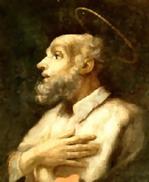'Sit On My Right!'
1. Continuing an ancient tradition, Psalm 110[109] which has just been proclaimed constitutes the primary component of Sunday Vespers. It is proposed in all four of the weeks into which the Liturgy of the Hours is divided. Its brevity is further accentuated by the exclusion in Christian liturgical usage of verse 6, which contains a curse. This does not do away with the difficulties it presents for exegesis or for its interpretation. The text is presented as a royal Psalm connected to the Davidic dynasty and probably refers to the rite of the sovereign's enthronement. Yet the Judaic and Christian tradition has seen in the consecrated king the profile of the Consecrated One par excellence: the Messiah, Christ.
Precisely in this light, the Psalm becomes a luminous hymn that the Christian Liturgy raises to the Risen One on the festive day that commemorates the Passover of the Lord.
Two divine oracles
2. Psalm 110[109] has two parts, both of which are characterized by the presence of a divine oracle. The first oracle (cf. vv. 1-3) is addressed to the sovereign on the day of his solemn enthronement "at the right hand" of God. that is, next to the Ark of the Covenant in the Temple of Jerusalem. The reminder that the king was "begotten" by the Lord was part of the official protocol for his coronation, and acquired for Israel the symbolic value of investiture and protection, since the king was God's lieutenant in the defence of justice (cf. v. 3).
Of course, in the Christian interpretation, that divine "begetting" actually takes place and presents Jesus Christ as the true Son of God. This is likewise what happened in the Christian interpretation of another famous royal-messianic psalm, the second in the Psaltery, where one reads this divine oracle: "You are my Son. It is I who have begotten you this day" (Ps 2: 7).
The Messiah, model of priesthood
3. On the other hand, the second oracle in Psalm 110[109] has a priestly connotation (cf. v. 4). The office of king formerly also included ritual functions, not only according to the Levitic priesthood but also following another connection: that of the priesthood of Melchizedek, the sovereign-priest of Salem, the pre-Israelitic Jerusalem (cf. Gn 14: 17-20).
In the Christian vision, the Messiah becomes the model of a perfect, supreme priesthood. The Letter to the Hebrews, in its central section, exalted this priestly ministry "after the order of Melchizedek" (5: 10), seeing it fully incarnate in the person of Christ.
Christ, 'at the right hand of power'
4. The first oracle is taken up several times in the New Testament to celebrate Jesus' messianic role (cf. Mt 22: 44; 26: 64; Acts 2: 34-35; I Cor 15: 25-27; Heb 1: 13). Christ himself, before the high priest and the Hebraic Sanhedrin, was to refer explicitly to our Psalm, proclaiming that he would henceforth "sit at the right hand of divine power", as it also says in Psalm 110[109] (Mk 14: 62; cf. 12: 36-37).
We will return to this Psalm on our journey through the texts of the Liturgy of the Hours. Now, at the end of our brief presentation of this messianic hymn, let us reaffirm its Christological interpretation.
Prediction of the coming of Christ
5. Let us do so with the syntheses that St Augustine offers us. In his Exposition on Psalm 109, which he gave during Lent in the year 412, he describes the Psalm as a true prophecy of the divine promises regarding Christ. The famous Father of the Church said: "It was necessary to know the only-begotten Son of God, who was to come among men, to take flesh and become a man through the nature he took on: he was to die, to rise again and to ascend into Heaven, where he was to sit at the right hand of the Father and fulfil all he had promised among the peoples.... All this, therefore, had to be prophesied, had to be foretold, had to be signaled as destined to occur, in order not to give rise to fear by coming like a bolt from the blue, but rather to be anticipated with faith and hope.
This Psalm fits into the context of these promises; it foretells in clear and explicit terms the coming of our Lord and Saviour Jesus Christ, of whom we cannot have the slightest doubt that he was the Christ proclaimed" (Exposizioni sui Salmi, III, Rome, 1976, pp. 951, 953).
6. Let us now address our prayer to the Father of Jesus Christ, the one King and perfect and eternal Priest, so that he may make us a people of priests and prophets of peace and love, a people that praises Christ, King and Priest, who sacrificed himself to reconcile in himself, in one body, the whole of humanity, creating the new man (cf. Eph 2: 15-16).
To special groups
Dear Brothers and Sisters, I offer a warm welcome to all the English-speaking pilgrims and visitors present at today's Audience. I greet particularly the groups from the United States of America. Wishing you a pleasant stay in Rome, I cordially invoke upon you joy and peace in our Lord Jesus Christ. Happy vacation!
I extend my greeting to all the young people present, as well as to the sick and the newly-weds. Dear friends, may the light of Christ that we have contemplated reflected in the Assumption to Heaven of Mary Most Holy always brighten your lives and make you authentic witnesses of his Gospel.
This item 6167 digitally provided courtesy of CatholicCulture.org






